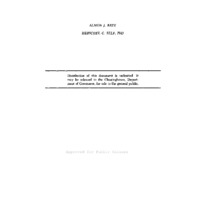-
Title
-
Target Detection on Side-Looking Radar when Image Motion can be Temporarily Delayed
-
Date
-
1967
-
Index Abstract
-
Not Available
-
Photo Quality
-
Complete
-
Report Number
-
AMRL TR 67-23
-
Creator
-
Bate, Almon J.
-
Self, Herschel C.
-
Corporate Author
-
Behavioral Sciences Laboratory
-
Laboratory
-
Behavioral Sciences Laboratory
-
Extent
-
36
-
Identifier
-
AD0667202
-
Access Rights
-
Distribution of this document is unlimited. It may be released to the Clearinghouse, Department of Commerce, for sale to the general public.
-
Distribution Classification
-
1
-
Contract
-
Laboratory Research - No Contract
-
DoD Project
-
7184
-
DoD Task
-
718404
-
DTIC Record Exists
-
No
-
Distribution Change Authority Correspondence
-
None
-
Distribution Conflict
-
No
-
Abstract
-
The study was conducted to determine the effect, on the recognition of targets of opportunity, of permitting subjects to stop and, when behind, speed up the presentation of dynamically displayed, high-resolution, coherent side-looking radar. The radar film was projected onto a 14-inch square, rear-projection screen at a scale of 1:94,000. On the screen, 1-inch displayed approximately 1.29 nautical miles of terrain. The radar imagery moved from the top to the bottom of the screen at a simulated aircraft speed of 2000 Knots in the normal mode and 4000 Knots in the 'catchup' mode. Thirty-eight radar navigator-bombardiers from the Strategic Air Command were randomly assigned to two groups. Subjects in group I were presented the radar imagery at a constant speed of 2000 Knots. Subjects in group II could view the radar imagery at a speed of 2000 Knots, stop the image movement for any length of time they desired up to a total accumulated 'stop time' of 45 seconds and could eliminate any accumulated stop time by speeding up the image movement to 4000 Knots. There was no significant difference between the two groups in number of correct or number of false positive responses; nor was there a significant difference in response latency. These results do not justify providing equipment to stop image motion for the purpose of improving target detection in the presentation of side-looking radar imagery of the quality used in this study.
-
Report Availability
-
Full text available
-
Date Issued
-
1967-11
-
Provenance
-
RAF Centre of Aviation Medicine
-
Type
-
report
-
Format
-
1 online resource
 AMRLTR67-023.pdf
AMRLTR67-023.pdf